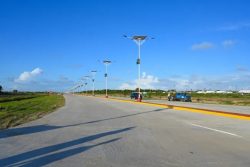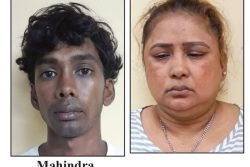 An interesting, different, very significant and perhaps fairly unusual production was presented on stage at the Theatre Guild Playhouse a week ago. “Greens and Golds 2: Guyana We Bawn” presented by Kreative Arts, a young and growing performing arts company directed by Jonathan Hamer and Esther Hamer had innovation and originality.
An interesting, different, very significant and perhaps fairly unusual production was presented on stage at the Theatre Guild Playhouse a week ago. “Greens and Golds 2: Guyana We Bawn” presented by Kreative Arts, a young and growing performing arts company directed by Jonathan Hamer and Esther Hamer had innovation and originality.
The production was dominated by dance, reflecting what seems to be the main interest and focus of the company, but integrated a good deal of drama and dramatisation, stage movement, music and poetry. The use and meaning in the printed programme of the designations “Debutante 1” and “Debutante 2” were not self-evident in most of the performance items, but the show was clearly presented by a mixed group, including experienced practitioners.
There was a dominant cast of children including at least one three-year-old, who, like the other children, had an amazing sense of purpose on stage with an understanding of the pieces they were in, self image and stage presence. They were, of course, obviously amateurs, and most likely debutantes, but one of the striking things about the performance was the way those children were managed, the way they danced, and their suggested understanding of the pieces. In some cases, it was evident that they were being trained to perform, which is not surprising, considering that the outfit Kreative Arts includes a dance school with children as students. It seemed even the youngest of them were taken seriously in whatever tutoring they received. In some instances where children and adults performed together, there was a fair degree of cohesion.
Because of what was presented there, as against what is often seen in other shows, and the unusual qualities of this one, the following is worth mentioning. Children are always being showcased on stage, sometimes by private dance schools demonstrating their work or staging their annual production. Dance is a very demanding discipline and dancers undergo years of training. This is demonstrated by the National School of Dance which starts formal classes at three years old and goes up. But outside of that formal process, in far too many instances when young children are seen on stage it appears they merely prance to the music or might have been taught the moves to a piece of music, but otherwise betray no intervention of real training. They might learn moves to a piece of music but they have not learned to dance.
In the Kreative Arts performance, however, a curious achievement was the way the youngest performers appeared to understand what they were doing even though errors were made and they looked like amateur debutantes; it seemed like a group being taught not only dance, but to perform on stage. This is important at this formative level because of its role at the highest levels. A strength of the National Dance Company, for instance, is the sense of not just dance but dramatic performance. Starters need to be trained in the technical fundamentals, not just to prance.
For Kreative Arts, the Artistic Director and Chief Choreographer is Jonathan Hamer with Esther Hamer as Assistant Director. They served as dance instructors in “Greens and Golds 2: Guyana We Bawn” for which Nicola Moonsammy was drama instructor. There were also Music Instructor: Kimberly Samuels, Stage Manager: Ayanna Waddell, with a production team of Moonsammy and Waddell along with Onix Duncan, Nirmala Narine, Darwin Peters, Kevin Dowers, Asif Mohamed and Dwayne Hackett.
There was a kind of celebratory concept in the presentation. It was outwardly patriotic, celebrating Guyana, Guyanese music and musicians, so that the land and its artists were featured. The title of the production foregrounded this, as did a number of the items and the fact that the performance was entirely driven by Guyanese music. The “greens and golds” seem symbolic of the nation – the national colours and landscape, but there was also an emphasis on the youth contained in the many youthful performers who we were told, represented the “greens”, while the “golds” were the older performers.
While one dramatisation – “Son of Plantation Rome” – was a tribute to a Guyanese musician, Bonny Alves, some of the others were performance poetry pieces proclaiming belonging, identification and nationality. These included performers Justine Hamer, Ezekiel Hamer, Emmanuel Hamer, Orihanthia Dowden, Felicity Grainger, Deja Bernard, Daid Hackett, Zuriel Martindale, Aleyha Semple and Gabrielle Singh.
The celebration of Guyanese music and musicians was done in a very specific way. There was a section on local folk songs, but even more pointedly, the programme was entirely driven by the music of Guyanese singers, songwriters, performers. But in addition, most of their compositions had thematic significance. “Rain” by Ruth Osman-Rose spoke to rich, flourishing change in a barren season; “Plug In” by Kwasi Ace was soca and fun, but a celebration of festivals and finding a source that ignites and reenergises; Samuel Medas’ “On Me” spoke of spiritual cleansing and new beginnings; others were Compton Hodges, Jackie Jaxx and Remar.
The music also reflected the presence of different ethnicities in the Guyanese nation, and this came in particularly with the works of Keith Waithe, as well as Jessica Xavier, and Alves. The musical presentations featured Justine Hamer and Aleyha Semple, as well as Quinn Allen, Soraya Crawford, Jasmine Hamer, Aryanna Hamilton, Safara Hutchins, Sarah Jamal, Kenisha Lynch, Kinaya McPherson and Mapenzi McPherson.
The many dance items also featured a number of more experienced performers such as Denise Bernard, Sonia Yarde, Meleesa Rambarran-Garrett, Sandra (and Nicola) Moonsammy, Misenga Singh, and Waddell; while Simone Bazil, Kevin Kellman and Ateisha Semple joined in other items.
Much of the production was unfortunately affected by lighting problems when the equipment suffered a breakdown, causing many presentations to go unlit. However, when lights returned later in the programme, quite a show of artistry was in evidence. There was colour and imagination suggesting that quite a lot was hidden in several items because of the lighting failure.
In particular, the dance item “Rain” choreographed by the Hamers to Ruth Osman’s music was outstanding. There were colourful designs using umbrellas, there was good effective lighting and memorable spectacle. All theatrical elements were called into use including shapes and images for which the dancers manipulated the umbrellas. These objects were made to actually perform – openings, closings, sweeps and twirls were done in time with dance, rhythm, music and lights.
The production honoured Alves with a dramatization of his life – “Son of Plantation Rome”, based on stories that he told. 2019 will mark 50 years of public engagement with music and production for Alves on the Guyanese stage. He has been a leading national singer, a producer, a filmmaker, music producer and film producer and his contribution in all these areas was recognised in what was a deserving tribute to him and an appreciation of the work he is doing.
Kreative Arts intends to have other productions on an annual basis in which they will pay tribute to other local artists. “Greens and Golds:Guyana We Bawn” was the third production of this type for Kreative Arts, starting in 2011.








